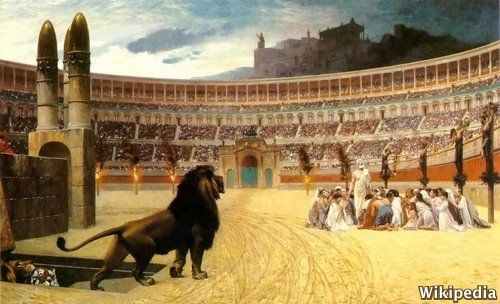The issue regarding the millennium centres on one particular passage in the Bible – Revelation 20. Five times in this chapter reference is made to a ‘thousand years’, which is the meaning of the word ‘millennium’. According to the first seven verses of Revelation 20, several things are said to happen in relation to these ‘thousand years’.
1. Satan is to be bound so that he cannot deceive the nations.
2. The souls of people who have suffered for Christ will reign with him.
3. Satan will be set free for a short time after the thousand years is over, and will go out to deceive the nations once more.
This passage of Scripture has been the occasion for a great deal of discussion and debate. Consider first the main issue that is involved.
The main issue
The basic issue in the matter of the millennium is whether or not Jesus will come again to set up an earthly kingdom that will last for 1000 years and which will be different from his eternal kingdom.

The suggestion is offered that in this future millennial kingdom Jesus will rule over the world, as it now exists, from the city of Jerusalem. Some people in the world will be loyal to him during this time, but others will rebel. Those who show themselves to be his enemies, he will subdue by force. Because Jerusalem will be his capital, this future 1000-year kingdom will have a Jewish flavour. For some interpreters, for example, the millennial kingdom will involve a rebuilding of the Jewish temple and a re-institution of the Old Testament sacrificial system.
So the basic question is whether or not Jesus will reign on this present earth in a distinctive way for 1000 years in the future.
The post-millennial view
Basically, three major views have been held with regard to this 1000-year reign of Christ. These viewpoints have been called the post-millennial view, the pre-millennial view, and the a-millennial view.
Consider first the post-millennial view. This view holds that Christ will come to set up his eternal kingdom after the millennium is over. According to this view, the preaching of the gospel will become more and more effective as the years go by. The world will get better and better as a consequence of the preaching of the gospel. More and more nations will become Christian, so that finally wars will cease, and a peaceful age will dawn, lasting for 1000 years. After that time is finished, Christ will return in all his glory. So in this, the post-millennial view, Christ returns after the millennium.
The pre-millennial view
The second view holds that Christ will come to earth before his 1000-year reign of peace begins. In this scenario, things will get worse and worse in this world. In fact, they will get so bad that Christ’s coming will be the only thing that could cure the earth’s problems. He will come in glory, subdue his enemies, and reign on earth for 1000 years.

The a-millennial view
According to the third view, Christ reigns now, even though his presence is not visible. In the future, when he returns in glory, his reign will be visible to all. With respect to the characteristics of the millennial reign, as described in Revelation 20, the a-millennial view sees all these things happening today.
Satan is bound so that he cannot deceive the nations as he did in Old Testament times; the souls of those who have suffered for Christ are now in Christ’s presence where they reign with him; and, at the end of this present age, Satan will be loosed for a short time before his final destruction by Christ as he returns in glory. In other words, the a-millennial view understands the 1000 years as a symbol that describes the present prolonged period of time since the resurrection of Christ, a period that will continue until his return in glory, when he will totally destroy Satan.
During this prolonged period, symbolised by the perfect figure of 1000 years, the gospel will be taken to all the nations of the world because Satan is bound, even though the devil’s power will cause suffering and martyrdom for many Christians. The souls of believers who suffer death during this period will rise instantly from their death, to reign with Christ for this period of ‘1000 years’. Their bodily resurrection, of course, awaits Christ’s return.
Better or worse?
These, then, are the three major viewpoints regarding the millennium. The post-millennialist sees things getting better and better throughout the present age; the pre-millennialist sees things getting worse and worse; while the a-millennialist sees things getting both better and worse at the same time. Things get better because the gospel is being spread to all the nations. But things also get worse because of the opposition of Satan to the gospel, even though the power to deceive the nations totally has been lost to him.

The decisive issues
In trying to decide among these various viewpoints, two key issues need to be considered. First of all, the question of a proper perspective on Old Testament promises needs to be considered. Abraham was given three great promises under the old covenant. He was promised a fruitful land. He was promised a numerous seed. And he was promised that he would be a blessing to all the nations of the world.
How are these promises of God to be fulfilled? The New Testament itself is quite specific in this matter. With respect to his being the heir of a ‘fruitful land’, it is said in Romans 4:13 that Abraham now has become heir of the world (literally, ‘inheritor of the cosmos’). His inheritance is not limited to Palestine, which was only a picture of paradise. Along with his seed, he will possess the new heavens and the new earth that Christ will create.
With respect to having a numerous seed, it is said in Galatians 3:26-29 that all believers in Christ, whether Jews or Gentiles, are the seed of Abraham. When all Gentile and Jewish believers are added together, the number must reach into the millions if not the billions. In this very fashion it may be seen that Abraham has become a father to a countless multitude and a blessing to all the nations of the earth. In this way, also, the promise of a millennial reign of Christ, in which Satan no longer deceives the nations, is being fulfilled before our very eyes.
The blessing of Abraham
Some interpreters insist that these promises to Abraham must yet be fulfilled in an earthly way. They believe that Abraham’s physical descendants must possess the land of Palestine during the millennium so that (as a Jewish race) they can bless the rest of the world. This viewpoint has great appeal in that it seems to fit literally the promises of the Old Testament.

But this kind of fulfilment would mark a retrogression to the older, shadowy forms of the old covenant. In addition, this kind of fulfilment would overlook the richer realisation of these very promises to Abraham that are occurring in the present day. As Paul writes: ‘Christ has redeemed us … that the blessing of Abraham might come upon the Gentiles in Christ Jesus, that we might receive the promise of the Spirit through faith’ (Galatians 3:13-14).
Interpreting Revelation
Secondly, the question of the correct way to interpret the book of Revelation needs to be considered. Often, it is thought that the book of Revelation begins in the early chapters at the time of the apostles as the Lord addresses the seven then-existing churches. Then it is assumed that the book progresses in an orderly chronological fashion, prophesying about the various ages that will follow in sequence. As a consequence, it is felt that chapter 20 and the reference to the 1000 years must occur as the end of the world approaches.
However, it should be noted that right in the middle of the book, in chapter 12, a clear reference is made to the birth of Jesus. A woman, representing the church, gives birth to a son who is destined to rule all the nations of the world with a rod of iron (Revelation 12:5). This description can fit no other event but the birth of Jesus. Yet when John wrote, this birth was not something in the future, but an event that had happened prior to the age of apostles. The events of Revelation 12 thus pre-date the things described in the earlier chapters of the book.
So the book of Revelation clearly does not follow a straight line of chronological development. Instead, it repeats over and over again the same cycle, from tribulation to praise, from tribulation to praise, from tribulation to praise. The period of tribulation describes the experience of the church under persecution, and the period of praise represents the age that will come with the return of Christ in glory.

So when Revelation 20 is being considered, the whole of the chapter should not be viewed as something yet future. Instead, the 1000 years in which people are being martyred even though Satan is bound represents once more the time of the church’s persecution. Even today, people are being martyred for Christ, and as a consequence their souls experience the ‘first resurrection’ after their death, so that they reign with Christ.
Numbers and symbols
A second matter to be considered in interpreting the book of Revelation is the symbolic use of numbers. The book begins with Christ standing among the churches. These churches number seven. Yet it is clear that Christ stands among more than seven churches. Although these seven churches were very real, they also were symbolic of the many churches that have existed across the ages.
Later, the book speaks of the 144,000 representing 12,000 from each of the twelve tribes of Israel. Once more, these numbers may include Jews who have been converted to Christ. Yet at the same time, the numbers are symbolic of all believers in Christ, whether Jews or Gentiles. For Paul speaks of Jewish and Gentile believers as the ‘Israel of God’ (Galatians 6:16). James addresses his letter, which is for the church of Christ, to the ‘twelve tribes’ (James 1:1), and Peter describes the church exactly in the terms used to designate Israel in the Old Testament (1 Peter 2:9).
Elsewhere, the book of Revelation talks about such periods as three and one-half years, (‘time, times and half a time’), forty-two months, and 1260 days (Revelation 11:2,3; 12:6,14; 13:5). All of these designations represent the same length of time. But, once again, the numbers have a symbolic significance. It is very likely that three and one-half years represent the whole of the New Testament era, just as another three and one-half years would represent symbolically the whole of the Old Testament era. Taken together, these symbolic numbers would total the ‘perfect number’ of seven, representing the whole of human history.

Dangers to avoid
So in the same way, the number of 1000 would have symbolic significance. It represents perfection, completion, wholeness. This number stands for the whole of the present age from the time of the first coming of Christ to his Second Coming. It is in this period that Satan is bound. As Jesus himself, in an explicit reference to the binding of Satan which made his miracles possible, said, ‘How can one enter a strong man’s house and plunder his goods, unless he first binds the strong man?’ (Matthew 12:29).
So, in conclusion, certain dangers must be avoided when considering the question of the millennium as it is mentioned in Revelation 20. First of all, we should avoid any return to the shadowy forms of the Old Testament, in which Jews have a favoured position that is not shared equally with Gentile believers. And secondly, Christians must be encouraged to concentrate on spiritual and eternal goals, rather than earthly ones, as they consider their present circumstances and the hope of the future.
On the positive side, all Christians should rejoice that Satan has been limited in his power throughout this age. Many people are coming to believe in Jesus, even though Satan seeks to persecute the church.






